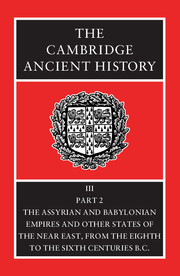Book contents
- Frontmatter
- Contents
- List of maps
- List of text-figures
- Preface
- PART I ASSYRIA AND BABYLONIA
- 21 Babylonia in the shadow of Assyria (747–626 B.C.)
- 22 Assyria: Tiglath-Pileser III to Sargon II (744–705 B.C.)
- 23 Assyria: Sennacherib and Esarhaddon (704–669 B.C.)
- 24 Assyria 668-635 B.C.: the reign of Ashurbanipal
- 25 The fall of Assyria (635–609 B.C.)
- 26 Assyrian civilization
- 27 Babylonia 605–539 B.C.
- 28 The culture of Babylonia
- PART II THE EASTERN MEDITERRANEAN AND THE BLACK SEA
- Chronological Table
- Note on The Calendar
- BIBLIOGRAPHY
- Index
- Map 11: Phoenician and Punic sites in Spain
- Map 13: Scythia
- Map 14: Thrace
- References
25 - The fall of Assyria (635–609 B.C.)
from PART I - ASSYRIA AND BABYLONIA
Published online by Cambridge University Press: 28 March 2008
- Frontmatter
- Contents
- List of maps
- List of text-figures
- Preface
- PART I ASSYRIA AND BABYLONIA
- 21 Babylonia in the shadow of Assyria (747–626 B.C.)
- 22 Assyria: Tiglath-Pileser III to Sargon II (744–705 B.C.)
- 23 Assyria: Sennacherib and Esarhaddon (704–669 B.C.)
- 24 Assyria 668-635 B.C.: the reign of Ashurbanipal
- 25 The fall of Assyria (635–609 B.C.)
- 26 Assyrian civilization
- 27 Babylonia 605–539 B.C.
- 28 The culture of Babylonia
- PART II THE EASTERN MEDITERRANEAN AND THE BLACK SEA
- Chronological Table
- Note on The Calendar
- BIBLIOGRAPHY
- Index
- Map 11: Phoenician and Punic sites in Spain
- Map 13: Scythia
- Map 14: Thrace
- References
Summary
This period includes the final years of the reign of Ashurbanipal, and those of his three successors in Assyria, his sons Ashur-etel-ilani and Sin-sharra-ishkun, and Ashur-uballit II for whose affiliation we have no evidence. Ashurbanipal is perhaps the best known of Late Assyrian kings, and his reign is in some respects the best documented. Yet of his final years we know little beyond the fact that he continued to be recognized at Nippur until his thirty-eighth year (631). Even the length of his reign remains in dispute, although one later inscription attributes to him a total of forty-two years, i.e. until 627. His sons are even more shadowy figures, of whose reigns in Assyria we are certain of neither their length nor their date, while the last king of the once great empire is attested solely in the Babylonian Chronicle recording his defeat (609). Indeed the extant evidence for the chronology of the final years of the Assyrian empire is so sparse and problematic that attempts to resolve the difficulties have included the suggestion of Ashurbanipal's (perhaps forced) abdication or retirement to Harran sometime before 627, for which there is no direct evidence, and the hypothesis, now clearly unacceptable, that Sin-sharra-ishkun and Ashur-etel-ilani were one and the same person. These chronological problems are discussed in more detail below (pp. 166ff).
- Type
- Chapter
- Information
- The Cambridge Ancient History , pp. 162 - 193Publisher: Cambridge University PressPrint publication year: 1992
References
- 2
- Cited by

